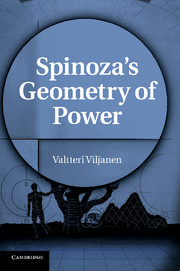Book contents
- Frontmatter
- Contents
- Acknowledgements
- Abbreviations
- Other sources
- Introduction
- Chapter 1 Spinoza on being
- Chapter 2 Causation and geometry
- Chapter 3 Power, existence, activity
- Chapter 4 The derivation of the conatus doctrine
- Chapter 5 The meaning of the conatus doctrine
- Chapter 6 Geometrical dynamics of individuality
- Conclusion
- Bibliography
- Index
Chapter 2 - Causation and geometry
Published online by Cambridge University Press: 07 October 2011
- Frontmatter
- Contents
- Acknowledgements
- Abbreviations
- Other sources
- Introduction
- Chapter 1 Spinoza on being
- Chapter 2 Causation and geometry
- Chapter 3 Power, existence, activity
- Chapter 4 The derivation of the conatus doctrine
- Chapter 5 The meaning of the conatus doctrine
- Chapter 6 Geometrical dynamics of individuality
- Conclusion
- Bibliography
- Index
Summary
As we have seen, it is a central characteristic of Spinoza’s rationalism that everything can – at least in principle – be explained; there are no brute facts. Moreover, everything has its cause through which it can be explained. Indeed, according to Spinoza, not only the existence of everything that exists but also the non-existence of everything that does not exist requires an explanation:
For each thing there must be assigned a cause, or reason, as much for its existence as for its nonexistence. For example, if a triangle exists, there must be a reason or cause why it exists; but if it does not exist, there must also be a reason or cause which prevents it from existing, or which takes its existence away. (1p11d2)
The essentialist, rationalist, necessitarian, and monist system explicated above is designed to offer us a proper metaphysical picture of why things exist, and of the way they do. And since that system’s specifically shaped entities – regardless whether we consider them sub specie aeternitatis or durationis – are real, what follows from their essences must be real effects. The ordered whole of real things is an infinite causal network. Reasons for thinking in this way will become clearer below, but on a general level it can be observed that this transition into causality evinces Spinoza’s silent but persistent sensitivity to a focal intuition of the Aristotelian tradition: that real entities are causally efficacious, or powerful, ones. This means that the ontological structure of things is played out in the causal register, and understanding the nature of Spinoza’s dynamic system must thus proceed through an accurate analysis of the view of causality it involves.
The axioms concerning causes and effects are located at the beginning of the Ethics:
From a given determinate cause the effect follows necessarily; and conversely, if there is no determinate cause, it is impossible for an effect to follow. (1a3)
The knowledge of an effect depends on, and involves, the knowledge of its cause. (1a4)
So, causation involves necessity, nothing is outside of it, and effects are known through their causes. In addition to these highly abstract contentions, the latter half of the first part of the Ethics deserves to be taken up, for it discusses first and foremost God’s causality. In fact, a proposition we are already familiar with, 1p16, signals the beginning of the discussion. It would be difficult to overestimate the importance of that proposition, for in it and its corollaries Spinoza designates what his basic ontological tenets amount to when put in causal terms. Recall that the proposition ‘[f]rom the necessity of the divine nature there must follow infinitely many things in infinitely many modes (i.e., everything which can fall under an infinite intellect)’ turns, to a great extent, on the contention that ‘the intellect infers from the given definition of any thing a number of properties that really do follow necessarily from it (i.e., from the very essence of the thing)’, which, in turn, is a compact formulation of Spinoza’s essentialist understanding of the nature and structure of being. And then, with no forewarning, comes a statement concerning causality: ‘From this it follows that God is the efficient cause of all things which can fall under an infinite intellect’ (1p16c1).
- Type
- Chapter
- Information
- Spinoza's Geometry of Power , pp. 33 - 53Publisher: Cambridge University PressPrint publication year: 2011



